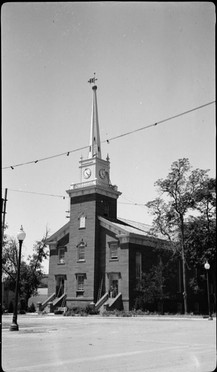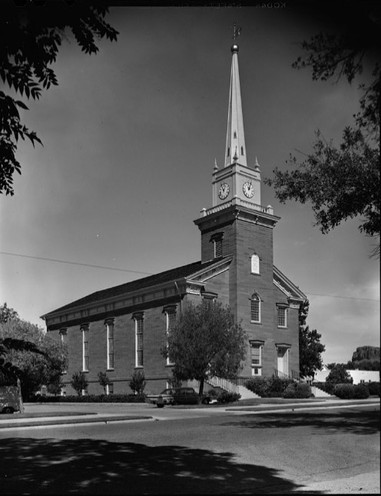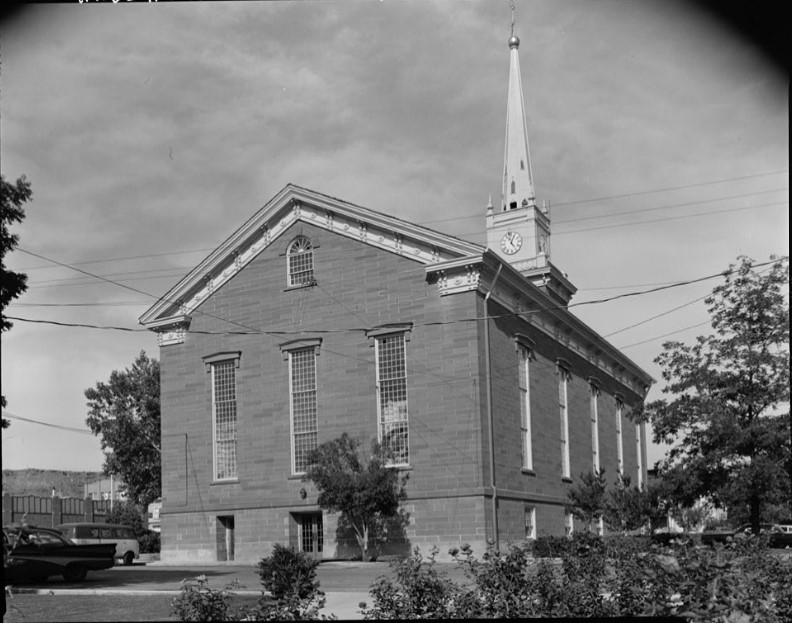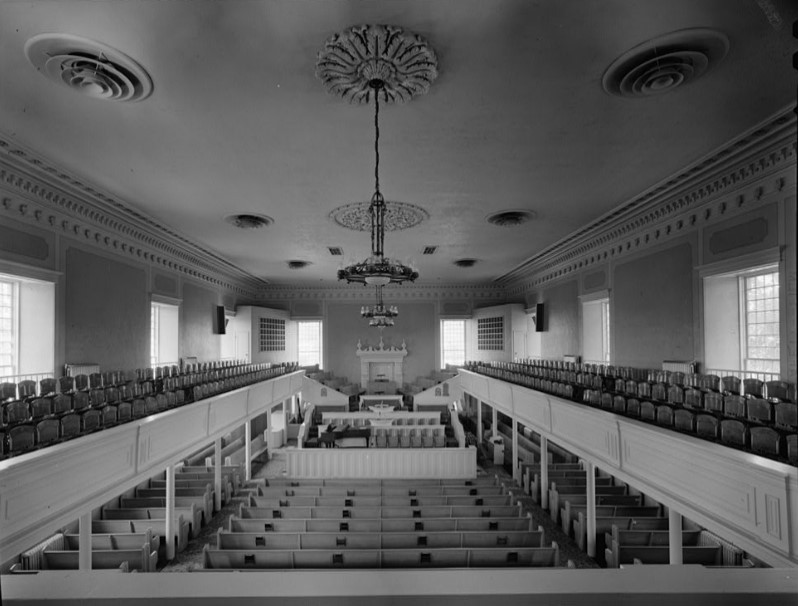St. George Tabernacle
Introduction
Text-to-speech Audio
Images
1940 photo of St. George Tabernacle by Delos H. Smith (HABS UT-10)

St. George Tabernacle east (front) and south elevations in 1968 photo by P. Kent Fairbanks (HABS UT-16)

Rear (west) elevation and clock on St. George Tabernacle in 1968 Fairbanks photo (HABS UT-16)

Interior view from balcony toward pulpit, view to west, 1968 Fairbanks photo (HABS UT-16)

Spiral staircase viewed from above in 1968 Fairbanks photo (HABS UT-16)

Backstory and Context
Text-to-speech Audio
The first families settled St. George in 1861. The area came to be nicknamed "Dixie" because of its warmer climate than northern Utah and the ability to grow warm-weather crops like cotton and grapes. The Mormon leader Brigham Young visited St. George and gave the measurements for the planned tabernacle building. Erastus Snow wrote a letter to Brigham Young on June 1st 1863 saying that they had laid the southeast cornerstone of the tabernacle that morning. A sandstone box was carved by Wilson Lund in August 1867 and was placed in a wall near the cornerstone as a "record stone." The record stone contained the Deseret News newspaper, a bottle of wine, and some coins; the box was recovered in 2016 during building renovations and is on display inside the tabernacle.
It took years of folks donating time, labor, money and talents to complete the building. Several other building projects - including the massive Mormon Temple - were underway at the same time in St. George, so the progress was slow. While the town contained stone masons and carpenters, skilled construction labor was a continual problem. Farming chores and work in nearby mines competed with building projects for the locals' time. The walls of the basement were finished in 1868 and the window frames were done in September 1871. In the final days of 1871, the final stone was laid and the last piece of roofing was installed. The wooden clock tower and thousands of panes of glass were installed in 1872. The glass was sent by rail to Salt Lake City and then hauled by wagon to St. George. The clock and bell made the same 275-mile wagon journey in 1873. The clock, from Ephraim Neils Byrum of New York City, is one of the few of its kind that survives; the 600-pound bell was manufactured in Troy, New York. Charles Lowell Walker wrote in 1872 that he had spent many "weary toilsome days" over the past five years laboring on the St. George Tabernacle, "lifting the heavy rocks in the wind, cold and scorching heat of this climate, yet I have felt happy and contented." Walker created his own time capsule from a tin can, found near the roof, containing a photo, poem and note. One snafu was remedied at the suggestion of Brigham Young - the three large oil lamp chandeliers blocked the view of the pulpit from the balcony, so the balcony was lowered by five feet, with steps leading down from the second story to enter the balcony. The building's interior was finally complete in 1876, including a carved wooden stairway with spiral curves designed by the building's architect, Miles Romney. The original pine benches have been replaced but one survivor is on display in the Daughters of Utah Pioneers McQuarrie Museum in St. George (another Clio entry).
The original musical organ was a pump organ by Needle and Company; a piano was added in 1908. The large pipe organ was new in the 1940s. Originally, there were two pulpits but only one remains, with a microphone; the other was in front of the area now holding a piano but was removed in the twentieth century.
The dedication was held on May 14th 1876 with Brigham Young, Jr. in attendance. Other notable speeches and gatherings took place in the St. George Tabernacle. A local Roman Catholic priest from Silver Reef said mass in the building on May 25th 1879. LDS leader Lorenzo Snow spoke on May 18th 1899 and urged the "Saints" (members of the Mormon faith) to pay a full tithe. The last Church President to speak in the Tabernacle was David O. McKay in 1955. The building was closed for repairs for three years in the late 1930s after sixty years of heavy use. Repainting and re-plastering took place and the benches and chandeliers were replaced. Theater-style seats took the place of the former benches in the balcony. A 2016 to 2018 project renovated the interior and helped stabilize the building to protect it during an earthquake.
Sources
Church of Jesus Christ of Latter-Day Saints. St. George Tabernacle, Historic Sites. May 1st 2020. Accessed September 10th 2020. https://history.churchofjesuschrist.org/subsection/historic-sites/utah/st-george/st-george-tabernacle?lang=eng.
Church of Jesus Christ of Latter-Day Saints. A Tabernacle in Utah's Dixie, Church History. May 1st 2020. Accessed September 10th 2020.
https://history.churchofjesuschrist.org/exhibit/historic-sites/st-george/st-george-tabernacle?lang=eng.
Massey, James C. Goeldner, Paul et al. Historic American Buildings Survey of St. George Tabernacle, St. George, Washington County, Utah. Survey No. U-16. Washington, DC. National Park Service, 1968.
https://www.loc.gov/item/ut0146/
https://www.loc.gov/item/ut0146/
https://www.loc.gov/item/ut0146/
https://www.loc.gov/item/ut0146/
https://www.loc.gov/item/ut0146/
